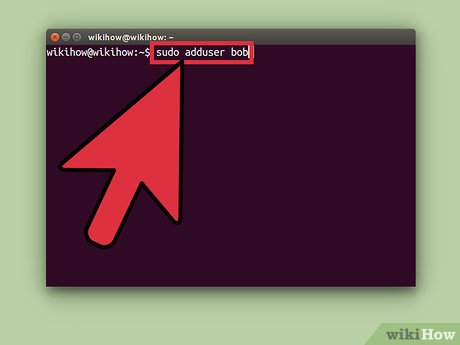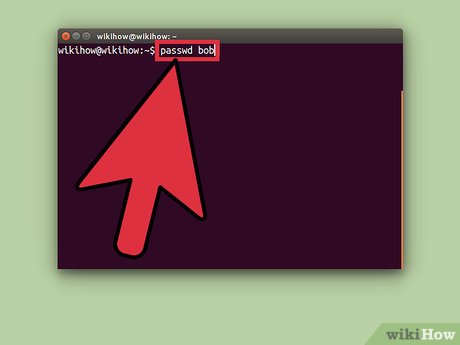How to Manage Users in Linux
Method 1 of 4:
Adding Users
-
 Type adduser -d /home/users/ into the command line.
Type adduser -d /home/users/ into the command line.- Example: adduser bob -d /home/users/bob
-
 Type passwd and press return to set a password for the new user.
Type passwd and press return to set a password for the new user.- Type the new password.
- Confirm the password.
Method 2 of 4:
Modifying Users
Changing Passwords
-
 Type passwd in the command line.
Type passwd in the command line. -
 Enter the new password for the user.
Enter the new password for the user.- Note: the cursor will not move however your password is being typed.
-
 Confirm the new password.
Confirm the new password.
Method 3 of 4:
Removing Users
-
 Type userdel into the command line to delete a user.
Type userdel into the command line to delete a user.- Example: userdel bob
-
 Type userdel -r to also delete their home folder and files.
Type userdel -r to also delete their home folder and files.
Method 4 of 4:
Sudo and Su
Terms
- sudo: Switch User and Do
- Executes a command as root or another use while maintaining your current session.
- su: Switch User
- Switches your session to another user.

- Switches your session to another user.
Usage
-
 Type sudo before a command to execute the command as the root user. You will be prompted for a password.
Type sudo before a command to execute the command as the root user. You will be prompted for a password.- Example: sudo apt-get install telnet
-
 Type sudo before a command to execute the command as another user on the system. You will be promoted for that users password.
Type sudo before a command to execute the command as another user on the system. You will be promoted for that users password.- Example: sudo bob telnet localhost 22
-
 Type su to switch your command line session to the root user. You will be promoted for a password.
Type su to switch your command line session to the root user. You will be promoted for a password.- Type logout to switch back.
-
 Type su to switch your command line session to another user. You will be promoted for their password.
Type su to switch your command line session to another user. You will be promoted for their password.- Type logout to switch back.
5 ★ | 1 Vote
You should read it
- How to change Windows user account password using Command Prompt
- How to Change a Computer Password Using Command Prompt
- How to Hack Into a Windows User Account Using the Net User Command
- The command changes user in Windows
- How to Bypass Windows 7 Password
- Instructions for changing Windows passwords without having to remember the old password
- USER_NAME function in SQL Server
- How to reset WSL user password
May be interested
- How to manage packages on RPM-based Linux distributions with DNF
 this tutorial will show you how to install and manage software packages on rpm-based linux distributions like fedora and red hat enterprise linux (rhel) using dnf.
this tutorial will show you how to install and manage software packages on rpm-based linux distributions like fedora and red hat enterprise linux (rhel) using dnf. - How to Launch Programs from Command Line on Linux
 most linux distributions have a graphical user interface that allows us to open programs just by clicking on the program icon in the apps menu. however, sometimes you may want to launch programs from terminal. terminal is a powerful tool that allows users to launch programs and manage linux systems through keyboard commands. today's tipsmake will show you how to launch programs from terminal on linux.
most linux distributions have a graphical user interface that allows us to open programs just by clicking on the program icon in the apps menu. however, sometimes you may want to launch programs from terminal. terminal is a powerful tool that allows users to launch programs and manage linux systems through keyboard commands. today's tipsmake will show you how to launch programs from terminal on linux. - 9 most popular Linux package managers today
 the common point between all linux distributions is that they need to be able to install new software packages into the system. various package managers are available, allowing users to install, manage and delete packages easily and quickly.
the common point between all linux distributions is that they need to be able to install new software packages into the system. various package managers are available, allowing users to install, manage and delete packages easily and quickly. - 7 ways to run Linux software on Windows
 linux users want to run windows software on linux, whereas windows users want to use linux software. even if you are looking for a better development environment, more powerful command-line tools, you can run linux software without removing windows.
linux users want to run windows software on linux, whereas windows users want to use linux software. even if you are looking for a better development environment, more powerful command-line tools, you can run linux software without removing windows. - How to check and manage disk space in Linux
 a common problem is that updates fail due to a lack of disk space, but there are some simple tests that users can perform when they encounter an error message, to keep critical systems smooth operation.
a common problem is that updates fail due to a lack of disk space, but there are some simple tests that users can perform when they encounter an error message, to keep critical systems smooth operation. - How to find, set and change IP addresses on Linux
 ip address is like a computer phone number. computers use it to communicate with other devices and vice versa. here are some simple ways to manage ip addresses on linux.
ip address is like a computer phone number. computers use it to communicate with other devices and vice versa. here are some simple ways to manage ip addresses on linux. - 5 best Linux distributions for Windows users
 in this article, tipsmake.com will introduce you to the best linux distributions for those who have just converted from the windows environment.
in this article, tipsmake.com will introduce you to the best linux distributions for those who have just converted from the windows environment. - 6 best Linux distributions for Windows users
 linux is the most known and used open source operating system. whether you are looking for a suitable operating system for your laptop, workstation, desktop, gaming, a/v editing or server, you will always find the right linux distribution for your needs. your specific needs.
linux is the most known and used open source operating system. whether you are looking for a suitable operating system for your laptop, workstation, desktop, gaming, a/v editing or server, you will always find the right linux distribution for your needs. your specific needs. - How to Learn Linux
 learning linux is not a one day task but it isn't herculean either. linux can be a good and safe os for both home and enterprise level users. keep in mind before saying 'hey, i'm going to start working on linux from tomorrow' that there is...
learning linux is not a one day task but it isn't herculean either. linux can be a good and safe os for both home and enterprise level users. keep in mind before saying 'hey, i'm going to start working on linux from tomorrow' that there is... - 8 best Linux distros for pentest
 linux users have a lot of free operating systems to choose from when it comes to pentests. if you're a linux user, it's time to check out some of these cybersecurity-related linux distributions.
linux users have a lot of free operating systems to choose from when it comes to pentests. if you're a linux user, it's time to check out some of these cybersecurity-related linux distributions.

















 How to Use Radio Tray on Linux
How to Use Radio Tray on Linux How to Become Root in Linux
How to Become Root in Linux How to Check the IP Address in Linux
How to Check the IP Address in Linux How to Create and Edit Text File in Linux by Using Terminal
How to Create and Edit Text File in Linux by Using Terminal How to Install Debian
How to Install Debian How to Install Software in Debian Linux
How to Install Software in Debian Linux